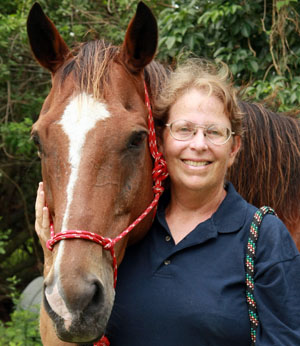Back in February, I attended Althea, a fundraiser for the Equestrian Aid Foundation. As I wandered through the crowd, introducing myself and interviewing people, one couple did a double take. I hadn’t recognized them, but they recognized me.
“We know you,” Tony Yanketis said. “We bought a horse from you a long time ago.”
Which is how, sometime later, I found myself back at their lovely farm in Caloosa, catching up with a horse I’d known in its youth, now quite grown up. Really grown. A very tall, very solid, black and white paint mare I had named Gypsy.
I never set eyes on her until she arrived at my house in 2002, only her picture online. And all because I walked past the bulletin board at the back of the Red Barn feed store. A dangerous thing, that bulletin board. That day, there had been a sheaf of papers clipped together advertising lots of foals, all needing good homes.
This was during the horrible Premarin time. Some of you might recall: Premarin, a drug for menopausal women produced from pregnant mares’ urine (hence the name) kept countless pregnant mares cooped up in stalls. Many of the mares and stallions were draft horses or draft crosses, because they put out more urine. People collected it, and when the foals were born, they were unwanted byproducts.
Premarin was a money-maker. The foals were not. Rescues sprang into action, trying to find them homes. A local woman had partnered with a rescue in Virginia. I went to their web site and found Gypsy, who was three months old and weaned, but otherwise hadn’t been handled. And, because it seemed like a good idea at the time, I picked out a buckskin gelding as well, sent money, and a few weeks later, a big, six-horse stock trailer pulled up out front.
The buckskin was closest to the door. The driver tried to coax him out, but 15 minutes later the colt was still in place, refusing to be handled or take a scary step down out of the trailer.
“Let’s try the other one,” I suggested. “Maybe she’ll be better.”
He swung open the partition between the two, I clipped a lead rope to the paint filly’s halter, and Gypsy stepped down as if she had done it every day of her life. Looking completely relaxed, she marched away from the trailer, surveying her new surroundings calmly. The gelding, whom I named Irish, took a giant leap out of the trailer (the driver had his lead) and scurried behind her.
Like a queen accepting her due, Gypsy stepped into a stall. Even in those first minutes, you could feel her calm presence, confidence and poise. She might have been barely three months old, but she was in charge.
Gypsy and Irish quickly learned the routine: leading, tying, brushing, feet. Irish was a bit flighty, but Gypsy was a rock, with a strange sense of humor. Nothing ever spooked her. She’d approach, examine, make judgment, and proceed. One of the odd things she enjoyed was backing up to my car and sitting on it.
I had other horses, adults, but Gypsy quietly ruled the herd. One 20-month paint gelding was at the bottom of the pecking order. The other horses charged him and ran him off from his feed and hay. But Gypsy decided she liked him, invited him to share her grain, and conferred status. After that, he moved up in the herd standing, and no one ever chased him again.
Time passed. The foals grew. Eventually, I found them a home at that farm in Caloosa with Tony and Ann, who bought both foals, still under a year old. They sold Irish, but Gypsy was theirs.
“She’s still a real character,” Tony said as I petted the horse, who now loomed over me. “She figures things out. You can see the wheels turning. Anyone can ride her. We’ve had our 3-year-old grandkids on her, and my wife’s 87-year-old mom. She’s always good as gold.”
Gypsy is also an escape artist.
“She likes to put her butt against her stall door and bend the latches,” Tony explained. “She can open any gate or door. We double-lock them now. But when she gets out, she never runs off. She wanders out, eats grass and comes back in. During the summer, sometimes she’ll stand with both of her front feet in the water trough.”
She gets along with everyone and is great on trails, he added.
“Very steady, never spooks,” Tony continued. “She plays with the two barn cats and all the dogs. Her personality is exceptional. She has these looks she gives you, like she knows the punchline to a joke. She is always glad to see us and loves going for a ride down the road. One time we were riding in River Rise State Park up in Lake City, and a big buck jumped out right in front of us. She didn’t even flinch. Oh, and she’ll do anything for a carrot.”
I shared some of the early stories about when I had her, and how she loved sitting on the car. “You know, she still loves to do that,” Tony said. “She sits on the truck’s tailgate.”
It’s nice to know some things don’t change.








